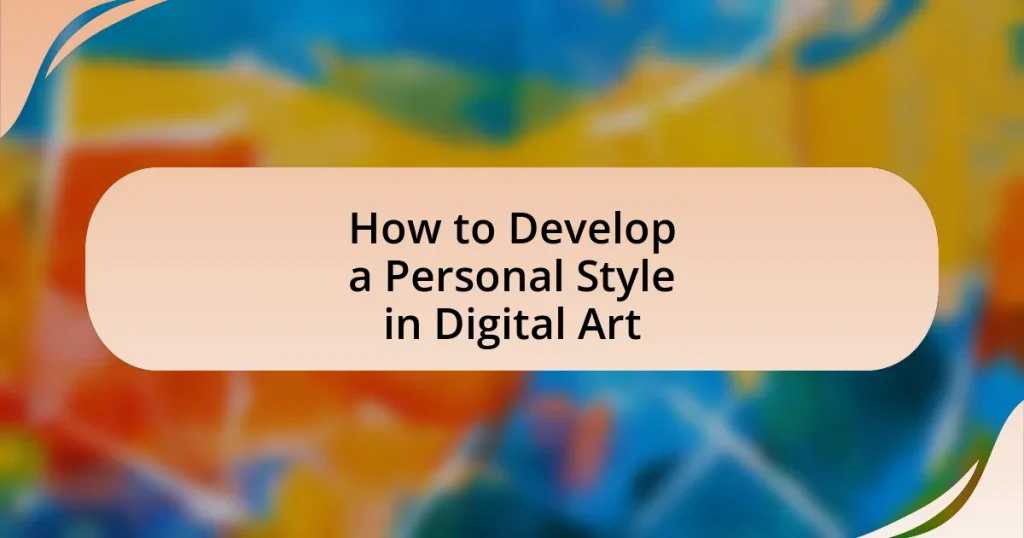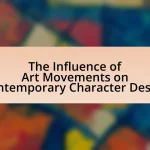Developing a personal style in digital art involves creating a unique visual language that reflects an artist’s individual preferences, techniques, and themes. Key elements defining this style include color palette, brushwork, subject matter, and composition, which collectively enhance an artist’s identity and influence viewer perception. Understanding and refining personal style is crucial for digital artists, as it distinguishes their work in a competitive market, fosters deeper connections with audiences, and opens up career opportunities. The article outlines practical steps for artists to develop their style, including consistent practice, experimentation, and seeking feedback, while also addressing common challenges such as self-doubt and the risks of imitation.
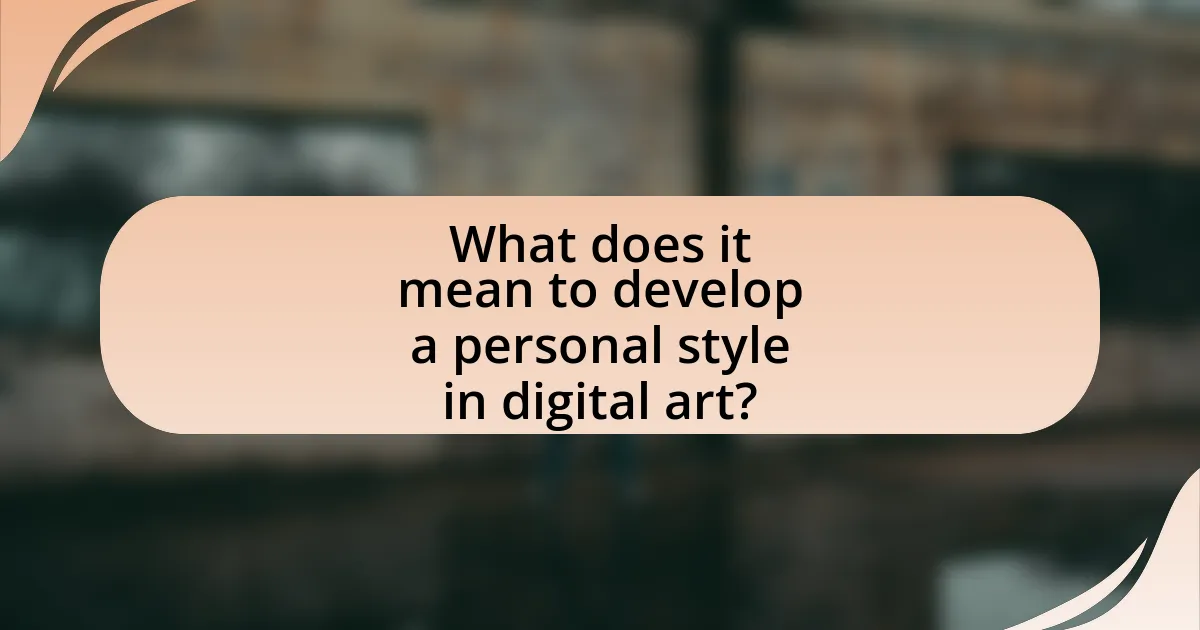
What does it mean to develop a personal style in digital art?
Developing a personal style in digital art means creating a unique visual language that reflects an artist’s individual preferences, techniques, and themes. This process involves experimenting with various tools, techniques, and subject matters to discover what resonates most with the artist. For instance, artists often analyze their influences, refine their skills, and consistently produce work that showcases their distinctive approach. Research indicates that artists who actively engage in self-reflection and seek feedback are more likely to cultivate a recognizable style over time, as they learn to express their artistic identity effectively.
How can understanding personal style enhance digital art creation?
Understanding personal style enhances digital art creation by allowing artists to express their unique perspectives and emotions, leading to more authentic and engaging artwork. When artists recognize their preferences in color, form, and technique, they can create cohesive pieces that resonate with their audience. Research indicates that artists who develop a distinct style are more likely to attract a dedicated following, as seen in the success of various digital artists on platforms like Instagram and Behance, where personal branding plays a crucial role in visibility and marketability.
What are the key elements that define a personal style in digital art?
The key elements that define a personal style in digital art include color palette, brushwork, subject matter, and composition. A distinct color palette allows artists to create a recognizable mood and atmosphere, while unique brushwork techniques contribute to the texture and depth of the artwork. The choice of subject matter reflects the artist’s interests and influences, making their work identifiable. Additionally, composition plays a crucial role in how elements are arranged, guiding the viewer’s eye and enhancing the overall impact of the piece. These elements collectively contribute to an artist’s signature style, making their work stand out in the digital art landscape.
How does personal style influence the viewer’s perception of digital art?
Personal style significantly influences the viewer’s perception of digital art by shaping their emotional response and interpretation of the work. When an artist employs a distinct personal style, it creates a recognizable visual language that can evoke specific feelings or thoughts in the viewer. For instance, a vibrant color palette may convey energy and optimism, while a muted, monochromatic scheme might evoke melancholy or introspection. Research indicates that viewers often associate certain styles with particular themes or emotions, which can guide their understanding and appreciation of the artwork. This connection between style and perception is supported by studies in art psychology, such as those conducted by researchers like Nancy Etcoff, who found that aesthetic preferences are closely tied to emotional responses. Thus, personal style not only defines the artist’s identity but also plays a crucial role in how the audience engages with and interprets digital art.
Why is developing a personal style important for digital artists?
Developing a personal style is crucial for digital artists because it distinguishes their work in a saturated market. A unique style enhances an artist’s brand identity, making their artwork instantly recognizable and memorable to audiences. This distinctiveness can lead to increased opportunities for commissions, collaborations, and sales, as clients often seek artists whose style aligns with their vision. Furthermore, a personal style reflects an artist’s individual perspective and creativity, fostering deeper connections with viewers who resonate with their artistic expression.
What role does personal style play in an artist’s identity?
Personal style is a crucial component of an artist’s identity, as it distinguishes their work from others and reflects their unique perspective. This individuality is often expressed through specific techniques, color palettes, and thematic choices that resonate with the artist’s experiences and emotions. For instance, renowned artist Vincent van Gogh’s distinctive brushwork and vibrant colors are integral to his identity, making his work instantly recognizable. Studies in art psychology indicate that personal style not only enhances an artist’s marketability but also fosters a deeper connection with their audience, as viewers often seek authenticity and originality in artistic expression.
How can a unique personal style impact an artist’s career opportunities?
A unique personal style can significantly enhance an artist’s career opportunities by distinguishing them in a competitive market. This distinctiveness allows artists to create a recognizable brand, attracting potential clients and collaborators who seek originality. For instance, artists like Yayoi Kusama and Banksy have built successful careers largely due to their unique styles, which have garnered widespread recognition and commercial success. Furthermore, a unique style can lead to increased visibility in galleries and exhibitions, as curators often look for artists who offer something different to engage audiences. This differentiation not only opens doors to more exhibitions but also enhances the likelihood of media coverage, further amplifying an artist’s reach and influence in the art community.
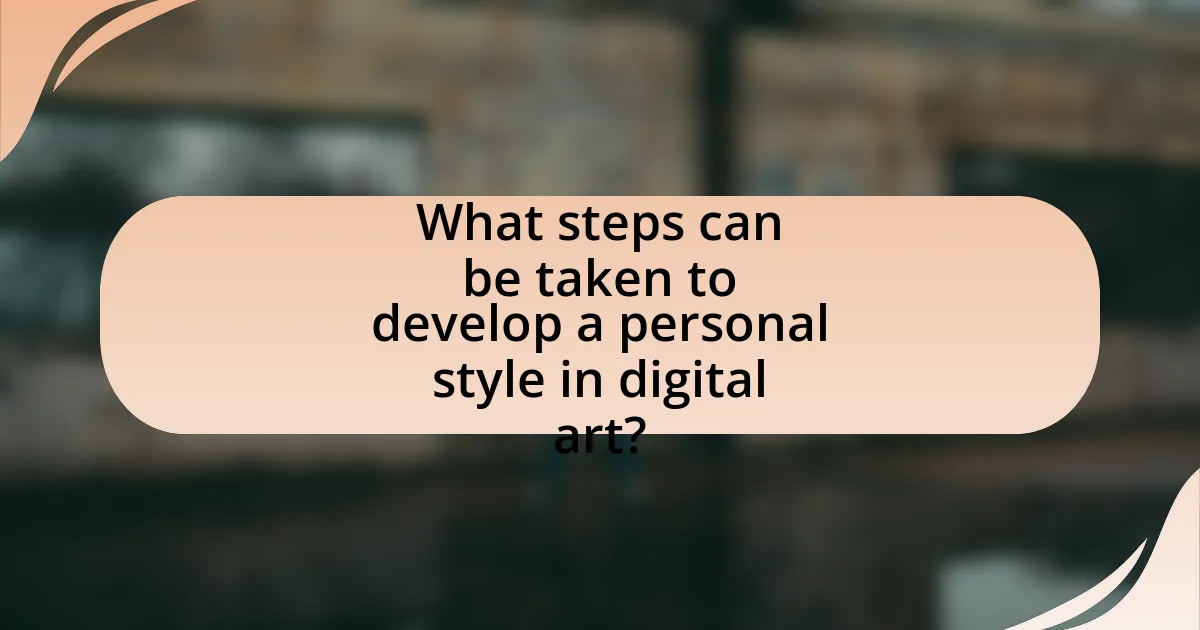
What steps can be taken to develop a personal style in digital art?
To develop a personal style in digital art, artists should engage in consistent practice, explore various techniques, and analyze their influences. Consistent practice allows artists to refine their skills and discover their preferences, while exploring different techniques helps them identify what resonates with them. Analyzing influences, such as favorite artists or styles, enables artists to incorporate elements they admire into their own work, ultimately leading to a unique artistic voice.
How can artists identify their influences and inspirations?
Artists can identify their influences and inspirations by analyzing their own work and recognizing recurring themes, styles, and techniques that resonate with them. This process often involves reflecting on the artists, movements, or genres that evoke strong emotional responses or admiration. For instance, an artist may notice that they frequently incorporate vibrant colors reminiscent of Impressionism or abstract forms akin to Cubism, indicating a connection to those styles. Additionally, artists can keep a visual journal or mood board, compiling images, quotes, and artworks that inspire them, which helps clarify their artistic preferences. Research shows that self-reflection and exposure to diverse artistic expressions significantly enhance an artist’s ability to pinpoint their influences, as noted in studies on creative development in art education.
What methods can be used to analyze and incorporate influences into personal style?
To analyze and incorporate influences into personal style, artists can utilize methods such as visual research, style experimentation, and reflective practice. Visual research involves gathering inspiration from various sources, including art history, contemporary works, and cultural references, which helps identify elements that resonate with the artist’s vision. Style experimentation encourages artists to create diverse pieces using different techniques and mediums, allowing them to discover what aligns with their personal aesthetic. Reflective practice involves regularly assessing one’s work and influences, enabling artists to refine their style based on feedback and self-evaluation. These methods are supported by studies in art education that emphasize the importance of exploration and reflection in developing a unique artistic voice.
How can experimentation lead to the discovery of a personal style?
Experimentation can lead to the discovery of a personal style by allowing individuals to explore various techniques, mediums, and themes, ultimately revealing their unique preferences and strengths. Engaging in diverse artistic practices encourages artists to step outside their comfort zones, fostering creativity and innovation. For instance, a study published in the Journal of Creative Behavior found that artists who frequently experimented with different styles reported higher levels of satisfaction and originality in their work. This process of trial and error helps artists identify what resonates with them, shaping their distinctive artistic voice over time.
What techniques can be employed to refine a personal style?
To refine a personal style in digital art, artists can employ techniques such as consistent practice, experimentation with various mediums, and studying the work of influential artists. Consistent practice allows artists to develop their skills and identify their unique preferences over time. Experimentation with different styles and tools encourages creativity and helps artists discover what resonates with them. Additionally, analyzing the work of influential artists can provide insights into techniques and themes that can be adapted to create a distinctive personal style. These methods are supported by the understanding that artistic growth is a cumulative process, where exposure and practice lead to the evolution of a unique artistic voice.
How can consistent practice contribute to style development?
Consistent practice significantly contributes to style development by allowing artists to refine their techniques and explore various creative expressions. Through regular engagement with their craft, artists can identify their preferences, experiment with different styles, and gradually develop a unique artistic voice. Research indicates that deliberate practice, defined as focused and repetitive engagement in a specific skill, leads to mastery and innovation in artistic endeavors. For instance, a study published in the journal “Psychology of Aesthetics, Creativity, and the Arts” by H. J. Chae and J. H. Kim found that artists who practiced consistently over time demonstrated greater originality and personal style in their work. This evidence underscores the importance of consistent practice in fostering individual artistic development.
What role does feedback play in refining an artist’s personal style?
Feedback is crucial in refining an artist’s personal style as it provides external perspectives that can highlight strengths and areas for improvement. When artists receive constructive criticism, they can identify patterns in their work that resonate with audiences or detract from their intended message. For instance, a study published in the Journal of Creative Behavior found that artists who actively sought feedback were more likely to evolve their styles and techniques, leading to greater originality and personal expression. This process of incorporating feedback allows artists to make informed adjustments, ultimately enhancing their unique artistic voice.
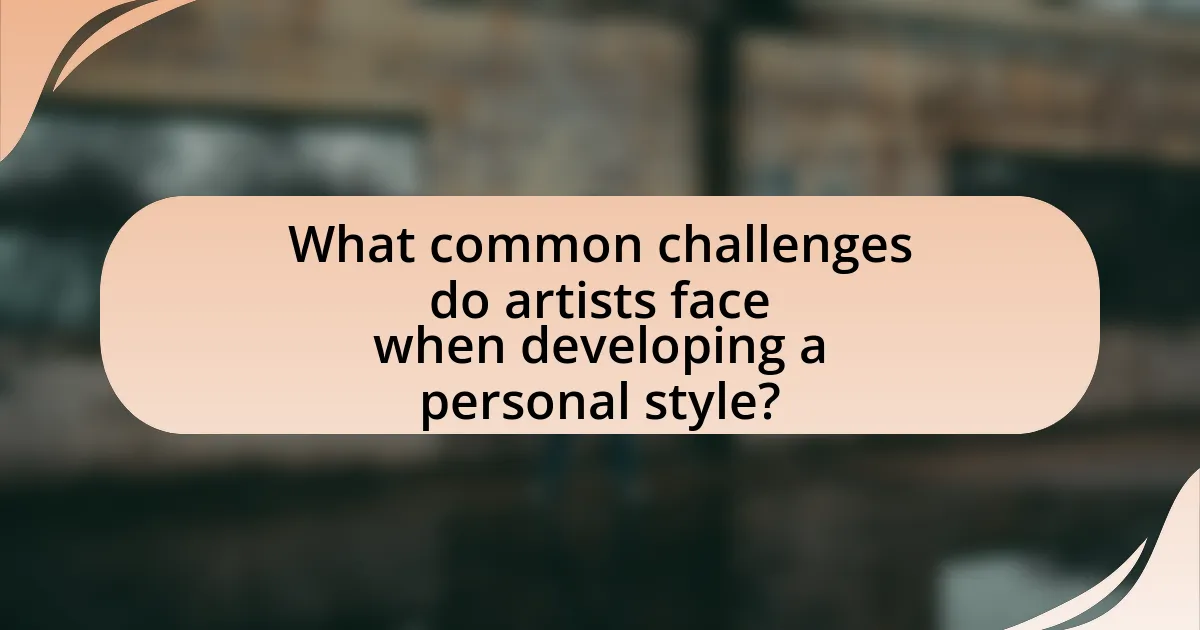
What common challenges do artists face when developing a personal style?
Artists commonly face the challenge of self-doubt when developing a personal style, which can hinder their creative expression. This self-doubt often stems from comparing their work to that of established artists, leading to feelings of inadequacy. Additionally, artists may struggle with consistency in their style, as experimentation can result in a lack of cohesion in their portfolio. The pressure to conform to market trends can also create obstacles, as artists might feel compelled to create work that appeals to a broader audience rather than focusing on their unique vision. Furthermore, the technical skills required to execute their ideas can pose a challenge, as artists may need to invest significant time in mastering tools and techniques. These factors collectively contribute to the difficulties artists encounter in establishing a distinctive personal style.
How can self-doubt hinder the development of a personal style?
Self-doubt can significantly hinder the development of a personal style by causing individuals to second-guess their creative choices and suppress their unique expressions. When artists experience self-doubt, they may conform to popular trends or imitate others instead of exploring their own ideas, which stifles originality. Research indicates that self-doubt can lead to decreased motivation and increased anxiety, both of which negatively impact creative output. For instance, a study published in the Journal of Creative Behavior found that individuals with high self-doubt often struggle to take creative risks, which are essential for developing a distinctive personal style.
What strategies can artists use to overcome self-doubt?
Artists can overcome self-doubt by implementing strategies such as setting achievable goals, seeking constructive feedback, and practicing self-compassion. Setting achievable goals allows artists to focus on small, manageable tasks, which can reduce feelings of overwhelm and build confidence as they accomplish each step. Seeking constructive feedback from peers or mentors provides external validation and can help artists gain perspective on their work, reinforcing their skills and abilities. Practicing self-compassion involves treating oneself with kindness during moments of doubt, recognizing that self-doubt is a common experience among artists, and reframing negative thoughts into more positive, supportive ones. These strategies are supported by psychological research indicating that goal-setting and social support can enhance self-efficacy and resilience in creative fields.
How can comparison with other artists affect personal style development?
Comparison with other artists can significantly influence personal style development by providing benchmarks for skill and creativity. When artists analyze the techniques, themes, and approaches of their peers, they can identify strengths and weaknesses in their own work. This process often leads to experimentation with new styles or methods, fostering growth and innovation. Research indicates that exposure to diverse artistic expressions can enhance an artist’s ability to synthesize different influences, ultimately contributing to a more unique and refined personal style. For instance, a study published in the Journal of Creative Behavior found that artists who actively engage with the work of others tend to develop a more distinct artistic voice over time.
What are the pitfalls to avoid when developing a personal style?
When developing a personal style in digital art, avoid the pitfalls of imitation, inconsistency, and neglecting feedback. Imitation can stifle originality; artists should focus on their unique voice rather than copying others. Inconsistency in style can confuse audiences and dilute brand identity, making it essential to establish a cohesive visual language. Neglecting feedback from peers and audiences can hinder growth; constructive criticism is vital for refining and evolving one’s style. These pitfalls can significantly impact an artist’s ability to establish a recognizable and authentic personal style.
How can artists avoid mimicking others too closely?
Artists can avoid mimicking others too closely by actively engaging in self-reflection and experimentation with their unique techniques and ideas. By analyzing their influences and identifying what resonates with them, artists can distill those elements into a personal style that reflects their individuality. Research indicates that artists who diversify their sources of inspiration and practice various styles are more likely to develop a distinctive voice. For example, a study published in the Journal of Creative Behavior found that artists who explore multiple genres and mediums tend to create more original work, as they synthesize different influences rather than replicate them.
What are the risks of being too rigid in one’s personal style?
Being too rigid in one’s personal style can lead to stagnation and a lack of creativity. When an artist adheres strictly to a specific style, they may miss opportunities for growth and experimentation, which are essential for artistic development. This rigidity can also alienate potential audiences who seek diversity and innovation in art. Furthermore, it may result in burnout, as the pressure to conform to a fixed style can stifle inspiration and motivation. In the competitive field of digital art, flexibility and adaptability are crucial for staying relevant and engaging with evolving trends and techniques.
What practical tips can help artists in developing their personal style?
Artists can develop their personal style by experimenting with various techniques and mediums to discover what resonates with them. Engaging in diverse artistic practices allows artists to identify their preferences and strengths, which can inform their unique style. Additionally, studying the work of other artists can provide inspiration and insight into different approaches, helping artists to refine their own voice. Keeping a sketchbook for daily practice encourages creativity and exploration, while seeking constructive feedback from peers can offer valuable perspectives on their work. These methods are supported by the understanding that personal style evolves through continuous practice and reflection, as noted in studies on artistic development.
How can setting specific goals aid in personal style development?
Setting specific goals aids in personal style development by providing clear direction and measurable benchmarks for progress. When individuals define precise objectives, such as mastering a particular technique or exploring a specific color palette, they create a structured framework that guides their creative process. Research indicates that goal-setting enhances motivation and focus, leading to improved skill acquisition and artistic expression. For instance, a study published in the Journal of Applied Psychology found that individuals who set specific and challenging goals performed better than those who did not, demonstrating the effectiveness of goal-oriented strategies in achieving desired outcomes in creative fields like digital art.
What resources are available for artists seeking to enhance their personal style?
Artists seeking to enhance their personal style can utilize various resources, including online courses, art communities, and books focused on artistic techniques. Online platforms like Skillshare and Udemy offer courses specifically designed to help artists explore different styles and techniques, allowing for practical application and feedback. Art communities such as DeviantArt and Behance provide spaces for artists to share their work, receive critiques, and engage with other creatives, fostering inspiration and growth. Additionally, books like “Steal Like an Artist” by Austin Kleon encourage artists to draw inspiration from various sources while developing their unique voice. These resources collectively support artists in refining their personal style through education, community engagement, and inspiration.
